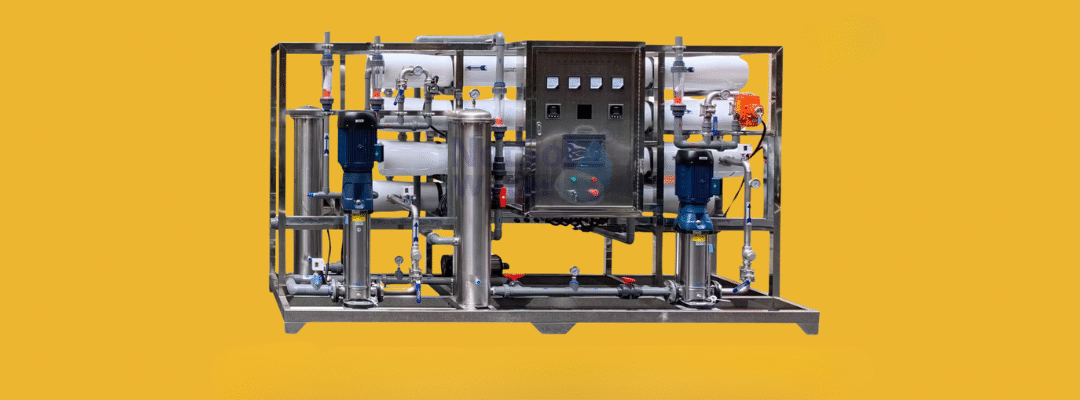Even a well-designed Reverse Osmosis (RO) plant is not immune to performance issues. Factors like feed water variability, aging components, and inconsistent maintenance can lead to:
- Low water output
- Rising TDS levels
- Pressure imbalances
- Membrane scaling or fouling
Identifying and resolving these problems early helps minimize downtime, protect membranes, and extend equipment life.
In this article, we walk you through the most common RO plant issues, real-world causes, and practical troubleshooting actions used by field technicians and plant engineers.
1. Low Permeate Flow or Reduced Output
Symptoms:
- Sudden drop in pure water production
- Increased differential pressure across membranes
- Unstable flow meter readings
Common Causes:
- Clogged pre-filters or carbon filters
- Fouled membranes (biological or scaling)
- Underperforming pump
- Obstructed flow restrictor
Troubleshooting Steps:
- Measure feed pressure and verify pump discharge.
- Replace clogged filters if pressure drop > 0.5 bar.
- Perform CIP (Clean-In-Place) using approved alkaline and acidic cleaners.
- Inspect for pump suction airlock or worn impeller.
- Remove and inspect flow restrictor for debris or biofilm.
Tip: Monitor differential pressure weekly. A rise >15% over baseline indicates fouling.
2. High TDS or Poor Product Water Quality
Symptoms:
- TDS above acceptable limit (e.g., >100 ppm for drinking)
- Taste, odor, or conductivity changes
Common Causes:
- Aged or damaged membranes
- Worn O-rings or housing leaks
- Bypass valve malfunction
- Post-carbon filter exhaustion
Troubleshooting Steps:
- Check feed vs permeate TDS to calculate % rejection.
- If rejection is <90%, plan for membrane replacement.
- Pressure test housings for micro-leaks or O-ring failure.
- Replace post-carbon filters and test UV output.
Example: A hospital RO unit showed 150 ppm TDS due to a cracked housing seal—detected via pressure decay test.
3. Pressure Drop Across the Membrane
Symptoms:
- Pressure differential exceeds 2 bar across the membrane
- Low recovery and unstable flow rate
Possible Causes:
- Suspended solids or microbial fouling
- Iron/silica accumulation
- Filter bypass due to cartridge deformation
Troubleshooting Steps:
- Check pressure gauges before and after each filter stage.
- Replace pre-filters and backwash multimedia filters.
- Perform alkaline CIP for organics or acid CIP for scaling.
- Test SDI of feed water—should be <5 for stable RO performance.
Field Insight: Systems using borewell water often need frequent MMF backwashing to prevent SDI spikes.
4. Membrane Scaling or Fouling
Symptoms:
- Gradual flow reduction
- Increasing conductivity and feed pressure
- White or brown deposits on removed membranes
Common Causes:
- High calcium or silica in feed water
- Improper or inconsistent antiscalant dosing
- Irregular flushing or long idle periods
Troubleshooting Steps:
- Analyze water for calcium, magnesium, and silica levels.
- Confirm antiscalant pump calibration and dosing rate.
- Adjust pH to 6.5–7.0 to reduce scaling potential.
- Schedule auto-flushing after shutdown periods >2 hours.
5. High Reject Flow or Low Recovery
Symptoms:
- Excess water draining to reject line
- Low permeate-to-reject ratio
Common Causes:
- Incorrect or damaged flow restrictor
- Low operating pressure
- Poor temperature compensation
Troubleshooting Steps:
- Maintain feed pressure between 15–25 bar for brackish water RO.
- Inspect and resize flow restrictor to match design recovery (typically 60–70%).
- Verify temperature sensor calibration.
- Review and correct recovery settings in the PLC, if used.
6. Pump or Motor Malfunction
Symptoms:
- No water flow or irregular pressure spikes
- Excessive noise, vibration, or overheating
Common Causes:
- Cavitation due to low feed tank level
- Bearing wear or shaft misalignment
- Voltage fluctuation or overload relay tripping
Troubleshooting Steps:
- Prime pump to remove airlocks.
- Check alignment and inspect couplings.
- Use clamp meter to verify motor amps.
- Replace worn bearings, seals, or impellers as needed.
7. Biological Contamination
Symptoms:
- Slimy biofilm inside tanks or filters
- Persistent odors or discoloration in water
Common Causes:
- Long idle periods without disinfection
- UV lamp failure or low ozone dosage
- High organic matter in feed
Troubleshooting Steps:
- Sanitize system with chlorine or food-grade biocides.
- Clean storage tanks and change post-filters.
- Measure UV intensity and replace lamps if weak.
- Schedule flushing cycle every 6–12 hours of inactivity.
8. Frequent Auto-Shutdowns or Alarms
Symptoms:
- PLC showing frequent alarms: low pressure, high TDS, tank full
- Unexpected system shutdowns
Common Causes:
- Loose sensor wiring
- Air bubbles in sensor lines
- Incorrect PLC logic or setpoints
Troubleshooting Steps:
- Check all transmitter connections.
- Recalibrate pressure, flow, and TDS sensors.
- Purge air from all pressure lines.
- Review PLC parameters for false triggers and correct thresholds.
9. Air Entrapment / Flow Instability
Symptoms:
- Bubbles in permeate meter
- Flow surges and pressure vibration
Common Causes:
- Suction line leaks
- Empty feed tank or improper pump priming
Troubleshooting Steps:
- Seal all suction-side fittings and elbows.
- Ensure feed tank never drops below suction level.
- Slowly prime after filter changes or pump maintenance.
10. Preventive Maintenance Tips
- Replace pre-filters every 6–8 months.
- CIP membrane when pressure drop rises >15%.
- Check dosing pump output and chemical stock weekly.
- Sanitize storage tank every 3 months.
- Keep daily logs of TDS, pressure, and flow readings.
- Flush the system before and after idle periods >24 hours.
Tip: Use an Excel log or SCADA trend report to detect early performance drops.
Frequently Asked Questions (FAQs)
Q1. Why does RO water quality suddenly drop?
Membrane damage, leaking O-rings, or failed carbon filters are typical causes.
Q2. How do I know if the RO membrane is clogged?
Increased pressure and reduced output indicate membrane fouling.
Q3. What causes high reject flow?
Incorrect flow restrictor sizing or low pressure.
Q4. How can I prevent membrane scaling?
Use accurate antiscalant dosing, correct pH, and regular flushing.
Q5. How often should RO systems be serviced?
Every 3–6 months for cleaning; pre-filters every 6–8 months.


Recent Comments